After being inspired by Raphael’s painting of the sea nymph Galatea in Rome’s Villa Farnesina, I decided to pay a visit to the artist’s hometown, the medieval city of Urbino in the Marche region of Italy.
From Rome I took a train to Pesaro and then hopped on the bus, passing lush green countryside on the way up to this hidden gem. You can also take the direct bus from Rome if you prefer. When I stepped off I looked up and saw the town and its famous ducal palace looming above me (unfortunately with the particularly striking palace facade covered in scaffolding but that wasn’t too disappointing).

The palace was built by Federico III da Montefeltro, a duke who ruled Urbino from 1444 until he died in 1482. He was a key figure in the Italian Renaissance, encouraging young artists like Raphael and building up one of the biggest libraries outside the Vatican at the time. His means of funding his passion for the arts was not so romantic however, as he made his fortune as a professional mercenary.
I remember coming across this picture of Federico by Piero della Francesca in Florence’s Uffizi gallery. I was struck by his interesting nose- he apparently lost his nasal bridge and his right eye in a jousting accident.
 I headed straight for the ducal palace on the first morning of my stay in Urbino. So did all the tour parties, made up mainly of groups of teenagers. I spent most of the visit trying to dodge them, but occasionally I did stop to listen to a few explanations, which were useful.
I headed straight for the ducal palace on the first morning of my stay in Urbino. So did all the tour parties, made up mainly of groups of teenagers. I spent most of the visit trying to dodge them, but occasionally I did stop to listen to a few explanations, which were useful.
When you first enter the palace, you come into a light and airy courtyard, which apparently became a blueprint for other similar courtyards in grand palaces around Italy.
After paying the very reasonable 5 euro entrance fee, I wandered up the wide monumental staircase. The beige marble decorations in here had grotesque-like patterns on them.
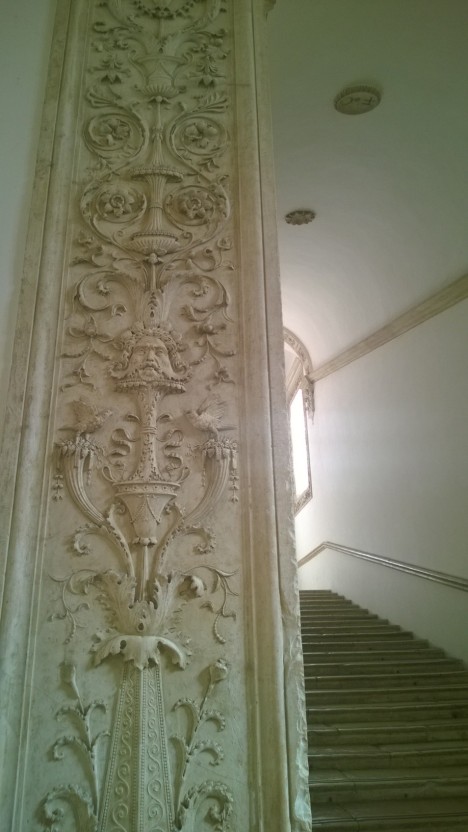 Inside, there are halls and halls full of art treasures. I also admired some of the original art of the palace, although not many furnishings remain and some decorations have been badly damaged. Here are some frescoes on the walls of the Men at Arms room:
Inside, there are halls and halls full of art treasures. I also admired some of the original art of the palace, although not many furnishings remain and some decorations have been badly damaged. Here are some frescoes on the walls of the Men at Arms room:
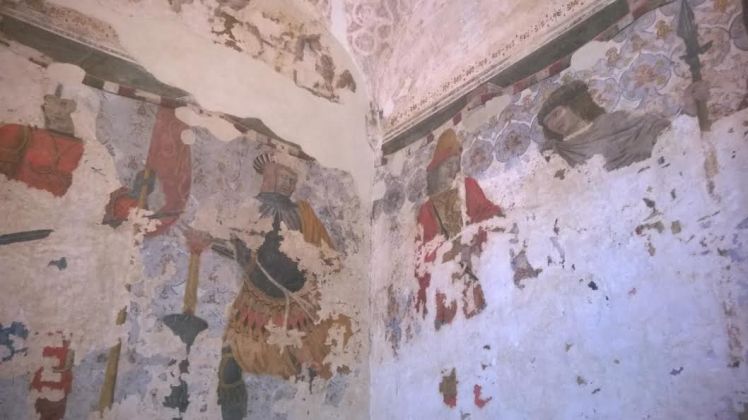 The room next door contained a huge painted wooden box bed. People used to sleep inside these wooden caskets to keep warm in winter, according to a tour guide I overheard.
The room next door contained a huge painted wooden box bed. People used to sleep inside these wooden caskets to keep warm in winter, according to a tour guide I overheard.
 Another interesting part of the palace was Federico’s small study. This had intricately decorated wooden panels depicting symbols of the liberal arts such as musical instruments, as well as pictures of prominent philosophers and saints, the Illustrious Men.
Another interesting part of the palace was Federico’s small study. This had intricately decorated wooden panels depicting symbols of the liberal arts such as musical instruments, as well as pictures of prominent philosophers and saints, the Illustrious Men.
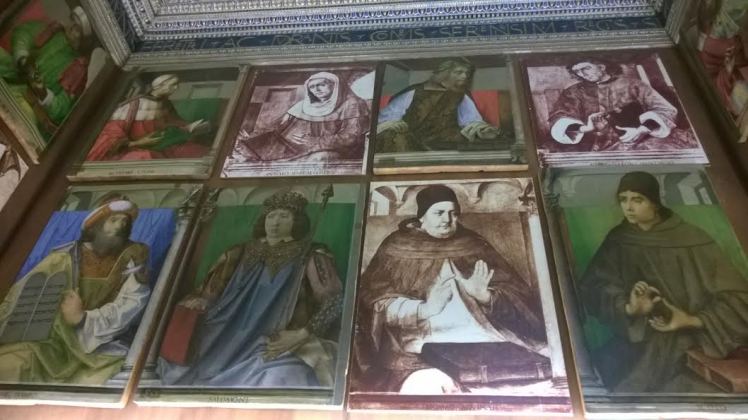 These stained glass windows were created by Timoteo Viti and dated between 1470-1523. They show the Annunciation and the coat of arms of the merchant Guidalotti family.
These stained glass windows were created by Timoteo Viti and dated between 1470-1523. They show the Annunciation and the coat of arms of the merchant Guidalotti family.
 Next I wandered back into the town, had lunch, then visited the home of Raphael, one of my favourite artists, who was born and brought up in Urbino.
Next I wandered back into the town, had lunch, then visited the home of Raphael, one of my favourite artists, who was born and brought up in Urbino.
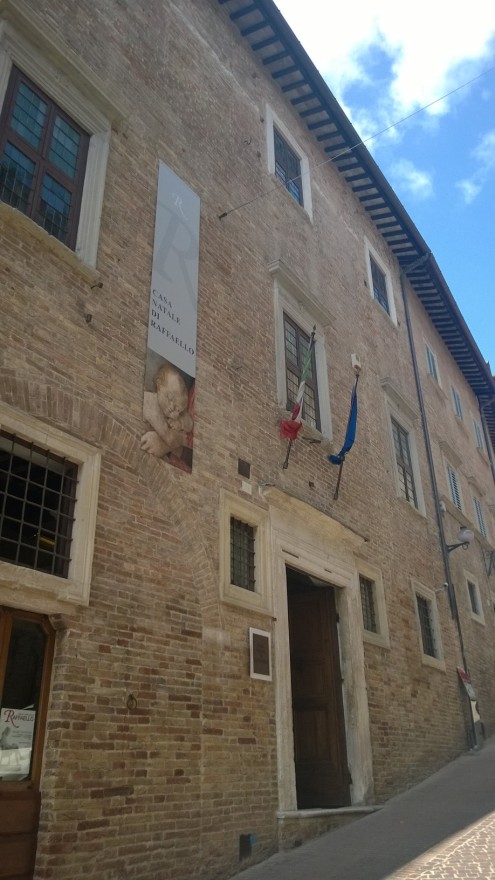 The house, now converted into a museum, contains mostly copies of Raphael’s greatest works, and a few pictures by his father Giovanni Santi and his contemporaries. The most interesting feature for me was this wall fresco in the room where Raphael was apparently born on the Holy Friday of 1483 (coincidentally today is Good Friday 2014). Portraying Mary and Child, the fresco was originally attributed to Santi, but some critics believe it could have been an early work by a young Raphael.
The house, now converted into a museum, contains mostly copies of Raphael’s greatest works, and a few pictures by his father Giovanni Santi and his contemporaries. The most interesting feature for me was this wall fresco in the room where Raphael was apparently born on the Holy Friday of 1483 (coincidentally today is Good Friday 2014). Portraying Mary and Child, the fresco was originally attributed to Santi, but some critics believe it could have been an early work by a young Raphael.
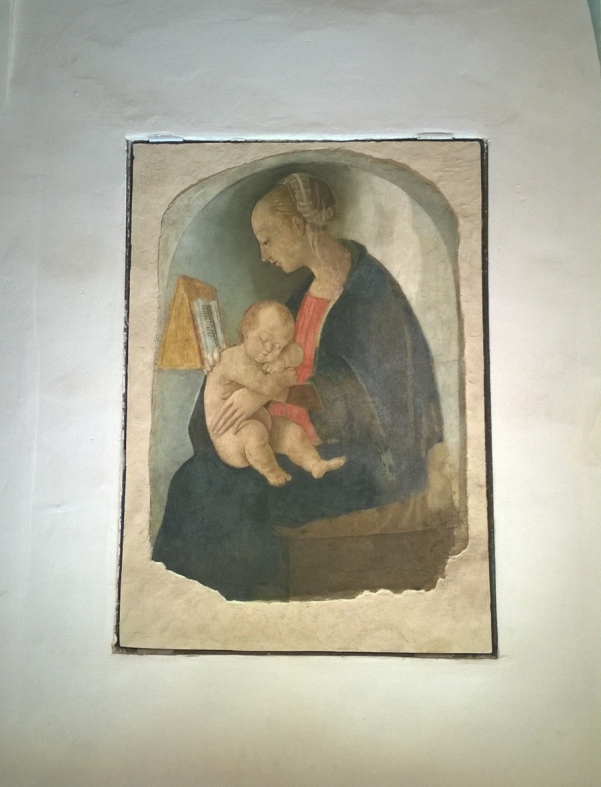 After seeing the house I walked up to the Albornoz fortress, a great point to admire a panoramic view of Urbino. I stayed here for a while and enjoyed the scenery like many other Urbino residents and visitors.
After seeing the house I walked up to the Albornoz fortress, a great point to admire a panoramic view of Urbino. I stayed here for a while and enjoyed the scenery like many other Urbino residents and visitors.
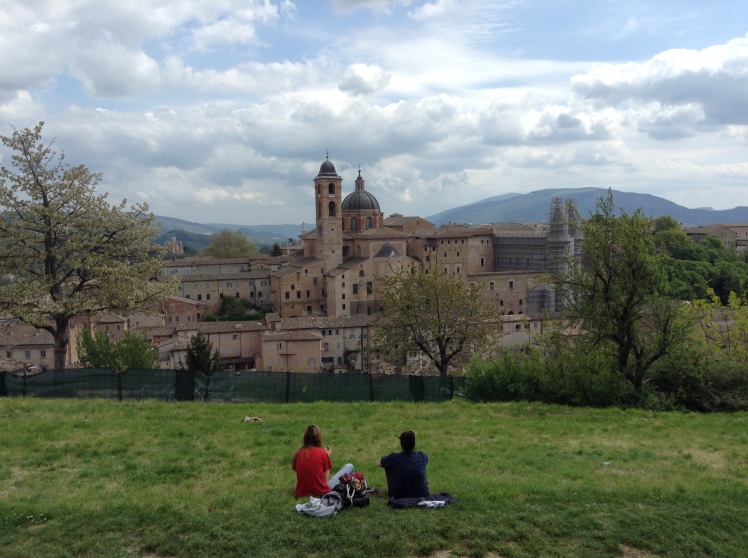 Later on I went to the oratory of San Giovanni Battista, which had an amazing set of early 15th century frescoes by Lorenzo and Jacopo Salimbeni. Restoration works were underway with lots of scaffolding around the walls, but I still got a sense of the magnificence of the art and would recommend visiting when you are in town. As it’s Good Friday, here is an image of the main fresco of the crucifixion:
Later on I went to the oratory of San Giovanni Battista, which had an amazing set of early 15th century frescoes by Lorenzo and Jacopo Salimbeni. Restoration works were underway with lots of scaffolding around the walls, but I still got a sense of the magnificence of the art and would recommend visiting when you are in town. As it’s Good Friday, here is an image of the main fresco of the crucifixion: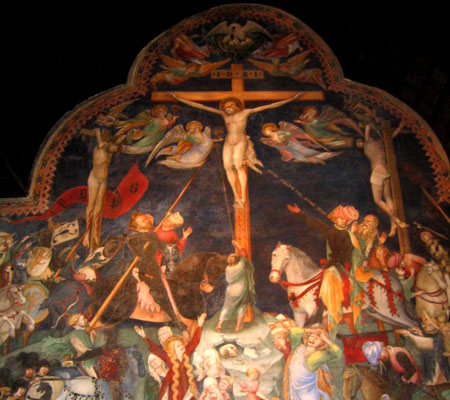 I also saw the Cathedral of Urbino, and enjoyed a glass of local wine in the square around it. I particularly liked the white neoclassical facade. Statues on the top of the church represent Faith, Hope and Charity, while others portray saints.
I also saw the Cathedral of Urbino, and enjoyed a glass of local wine in the square around it. I particularly liked the white neoclassical facade. Statues on the top of the church represent Faith, Hope and Charity, while others portray saints.
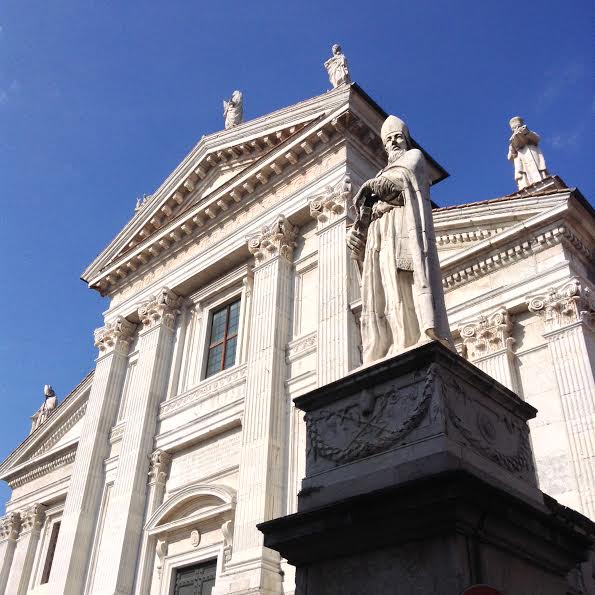 Urbino was exceptionally vibrant for such a small provincial town, partly due to all the university students. Its piazzas were really buzzing at night. So it’s a fun place to include on a tour around central Italy. You should prepare for quite a bit of exercise, because everywhere you go you have to climb up and down hills. The food I tried here was so lovely and so varied that it merited a separate blog post. Hope you enjoyed my tour of the sight-seeing gems for now.
Urbino was exceptionally vibrant for such a small provincial town, partly due to all the university students. Its piazzas were really buzzing at night. So it’s a fun place to include on a tour around central Italy. You should prepare for quite a bit of exercise, because everywhere you go you have to climb up and down hills. The food I tried here was so lovely and so varied that it merited a separate blog post. Hope you enjoyed my tour of the sight-seeing gems for now.
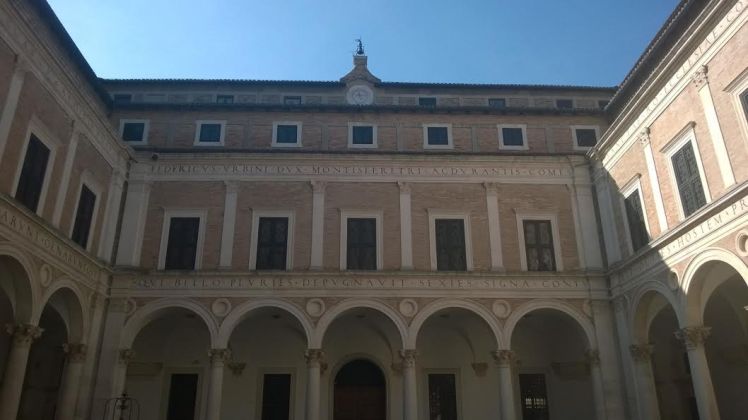
I’m glad that you appreciated Urbino, the Oratory is probably my favourite bit and not everyone visits it.
As a side note: buses of teenagers are nowhere to be seen outside April and early May (when school tours are on) and it’s often possible to visit the palace and Urbino without having to fight against the crowds.
Have a look at my Le Marche Photo Blog if you wish, for images of other amazing and (even more) unknown places in Le Marche. http://lemarchephotoblog.blogspot.com
Ah.. there are direct buses from Rome to Urbino
Hi Giulia, tx for your comments. I looked up the buses from Rome, which are another option, but they weren’t going at the times I wanted… the train and bus worked out fine for me as I had all day to get there 🙂 Bus could be better if you’re short on time…
Like Giulia, I’m glad you appreciated Urbino. I find it slightly melancholy, and if you’re interested to know why, or interested in Giovanni Santi, you might like to have a look at my blog post http://alysb.wordpress.com/2012/10/13/the-sad-side-of-urbino/ from which you can link to other posts about Urbino and its artists. I’m off to look at your post on Ascoli now!